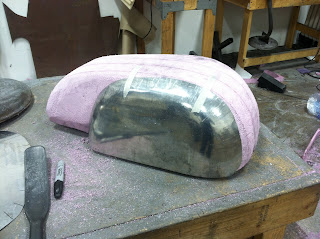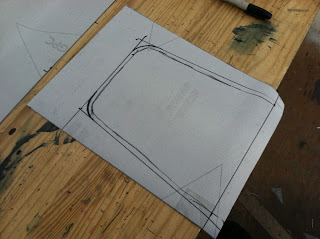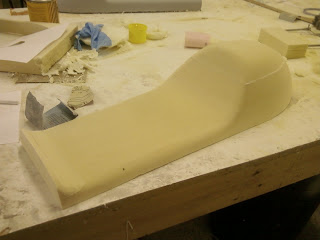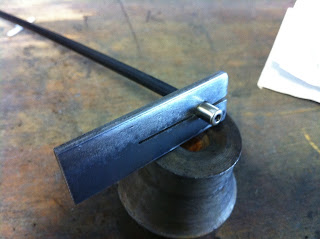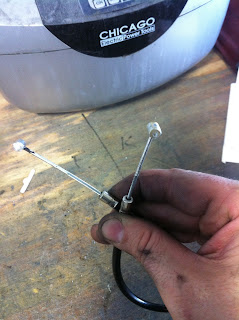Sunday, September 29, 2013
building an alloy cafe racer fender
I took some time to document building an aluminum fender for a bike I'm working on. I make quite a few of these parts but usually don't have time to record the process. I start with a piece of 14ga 3003 aluminum, cut to about 20" and 4-5" wide, depending on the style I'm going for.
The fender is a combination of two curves, the main curve to match the diameter of the wheel, and a tighter curve to match the profile of the tire. To get this shape the center of the fender needs to be stretched and the sides shrunk. Since the shrinking is minor, I'll use a dolly and soft slapper to do it, rather than a tuck shrinker which is for more dramatic shrinking.
I start by drawing a center line and two other lines each about 3/4" from the edges, the center line is for reference and the two other lines are so I have a guide to where shrinking and stretching part ways, I could do this by eye now, but doing the lines is habit and probably not bad practice. In theory, the lines off the edge mark metal which isn't either stretched or shrunk, so technically it's not moved. That's a good way of thinking about it.
I start off by hammering the center portion into a shot bag, and then going right to the dolly to bring the sides in with the soft slapper. Right away the fender starts to take shape, it's a pretty basic form so the only challenge really is to keep things even. I use the wheel to smooth out the hammer and shrink areas, then do a check on the tire. One more round of hammering the center and lightly shrinking the edges gets the curves where they should be. Another go in the wheel, and a second pass with a large radius anvil from side to side smooths the fender out. I use a ruler to make sure the edges are spaced evenly, some light working against the dolly brings them in where needed. The final check is done against the tire and the fender is ready for sanding and polishing.
Where to get this part
building an alloy cafe racer tank part 3
I put together the finishing up video of the aluminum tank I'm building for a customer's XS-650, this part includes turning an aluminum bung to match up with the filler cap threaded ring, and welding the bung into the tank. I don't weld the filler on the outside of the tank, even though that is the easier way, I weld on the inside so the cap can sit closer to the surface of the tank, it also keeps distortion down, welding on the outside can wind up wrinkling the top of the tank due to weld shrink. I didn't get much of the bottom of the tank construction or sanding before polishing, mostly because my priority is finishing the tank properly, so sometimes I use all my concentration on the tank and forget to record parts. Stay tuned though, I'll be making more videos, so any parts left out will probably find their way into future vids.
RCC's parts store (where you can get a tank like this)
Thursday, September 19, 2013
Wednesday, September 18, 2013
Handmade alloy cafe racer tank
I use something called a tuck shrinker to shrink edges, some people like to use an an edge shrinker, but hammering a tuck more effectively shrinks than a mechanical shrinker. Stretching the center is done with a hammer and shotbag. Lots of people new to metalworking are under the impression that the english wheel is the workhorse of the shop, but most of the shaping is actually done with the first two tools. The wheel is really a finishing and fine shaping tool.
I'm using a wooden buck I made years ago for this tank, since then I usually make a foam buck because it's not really necessary to have something as sturdy as wood when you're just using it as a shape reference. Wood is certainly nice when you need to clamp panels in really complex shapes or where really critical accuracy is required, but for most alloy tanks, getting things within half an inch or so is perfectly fine.
Monday, September 9, 2013
Building an alloy Manx tank
Going to do a little writeup on building an aluminum tank, recently I took some in process photos as I built a manx tank for a customer's cx500 cafe racer.
First I like to start with a pattern, foam is fine to use as a template, especially when it doesn't require an exact copy, but you're just working out a shape. It helps to figure out mounting and clearance issues with the bike before banging out any metal too.
Depending on your style, you can start forming any part of the tank first, I usually like to start the sides on manx types first, because the top is mostly flat and a lot simpler. I like to be able to put each side next to each other to guarantee symmetry.
Since the pics were just in progress pics, I'll detail more of the actual forming process in the next few days' posts.
Friday, September 6, 2013
How to do quality cafe racer seat upholstery (Part 2)
Since I use a flat fell type of seam for durability, I need to create a trim line offset from the edge of the foam by a little more than usual, I like to use about 1/2". This is where the vinyl will be trimmed and where I'll line up the edge of the skirt piece.
To stitch the skirting to the main seat piece, I use transfer tape to stick the pieces together before actual stitching, this keeps things from moving around and ruining the straightness of the seam. The first stitch is done on the backsides of the vinyl, then it's folded over and the next stitch is done about 1/4" from the first seam. This makes the skirting hang perpendicular to the main seat piece without any bunching.
Next, the back piece gets stitched to the main seat piece, I use transfer tape again to lock it in place so nothing bunches up while stitching. This piece can be cut extra large because it's trimmed to match the back piece of foam.
Once the back piece is stitched, the whole cover is temporarily put on the foam and the back piece is pinned to the back foam, this gives it the shape it will take on when the pad is done.
To make the back skirt piece, I use two pieces of transfer tape, one to fold the first 1/2" of vinyl over on itself, and the next piece on top of that fold.
The rear skirt is then stretched over the back piece of vinyl and pressed so the transfer tape holds it in place, then the pins are removed and the piece is unfolded and stitched.
The piece is then folded over and the second stitch is done, extra care has to be taken here because any mistakes will cause the back of the seat to be uneven.
The cover is then checked against the foam, when pulled tight it should be even and have no bunching anywhere.
The cover is then riveted to the base and pulled taught as it's riveted. Any excess material is trimmed off and hot melt adhesive can be used to flatten the creases against the fiberglass base.
All ready for installation!
Tuesday, September 3, 2013
How to do quality cafe racer seat upholstery
I've been upholstering my own seats for a few years now, and when looking back at the first ones, I'm a bit impressed at how they look now. Not blown away mind you, I'm a novice at best, but I think I can share some techniques with beginners that may help them along the way.
The style of pad I like to do is a separate upholstery unit, in my mind, it makes for a much cleaner look on the bike and is a lot easier to remove for underseat access than the snap cover type. This type is shown on my personal bike, yeah, I actually ride on the parts I make!
The first step in my process is to make a fiberglass base pan for the pad, I use an original seat for the mold, and wax it so the glass doesn't stick to it, a couple layers of chopped mat is stiff enough for this purpose. When it's all cured, I remove it and trim to the shape I want, I use templates for the seats I make all the time, it saves some measuring and marking time and ensures everyone's getting exactly what's in the picture.
Next I drill out holes for 1/8" rivets along the edge of the pan, I find rivets work best to hold down the material without starting tears in it.
Depending on the firmness desired, I make a base layer of at least 1/2" of high density closed cell foam, similar to yoga mats, or those floor covers for work areas. Spray adhesive or contact cement work well to hold the foam to the fiberglass base. The next layer(s) of foam should be a lower density type that adds a bit of cushion and lets the sewn material move a bit, it looks better than using only high density foam throughout.
With the foam layers adhered to the fiberglass base, I use a bandsaw, or a hand razor saw would work as well, to cut the foam using the edge of the fiberglass as a guide. This makes sure the foam is straight along the sides and won't make the covering look lumpy.
Next, and this is a very important step, (I've had people tell me some of the "really famous" builders don't do this and have problems with the covers tearing!), I cover the fiberglass edge in either a few layers of masking tape or gaffer tape. This keeps the abrasive fibers from rubbing holes in the vinyl covering... surprised that some people never think that far ahead.
The style of pad I like to do is a separate upholstery unit, in my mind, it makes for a much cleaner look on the bike and is a lot easier to remove for underseat access than the snap cover type. This type is shown on my personal bike, yeah, I actually ride on the parts I make!
The first step in my process is to make a fiberglass base pan for the pad, I use an original seat for the mold, and wax it so the glass doesn't stick to it, a couple layers of chopped mat is stiff enough for this purpose. When it's all cured, I remove it and trim to the shape I want, I use templates for the seats I make all the time, it saves some measuring and marking time and ensures everyone's getting exactly what's in the picture.
Next I drill out holes for 1/8" rivets along the edge of the pan, I find rivets work best to hold down the material without starting tears in it.
Depending on the firmness desired, I make a base layer of at least 1/2" of high density closed cell foam, similar to yoga mats, or those floor covers for work areas. Spray adhesive or contact cement work well to hold the foam to the fiberglass base. The next layer(s) of foam should be a lower density type that adds a bit of cushion and lets the sewn material move a bit, it looks better than using only high density foam throughout.
With the foam layers adhered to the fiberglass base, I use a bandsaw, or a hand razor saw would work as well, to cut the foam using the edge of the fiberglass as a guide. This makes sure the foam is straight along the sides and won't make the covering look lumpy.
Next, and this is a very important step, (I've had people tell me some of the "really famous" builders don't do this and have problems with the covers tearing!), I cover the fiberglass edge in either a few layers of masking tape or gaffer tape. This keeps the abrasive fibers from rubbing holes in the vinyl covering... surprised that some people never think that far ahead.
tomorrow - sewing the cover
Saturday, August 31, 2013
How to build a Cafe Racer Seat
Ok, everyone wants it, here it is. Here's how you do it, the definitive guide on making your "cafe racer" seat. If you really actually truly follow these steps, and really actually listen to what I'm saying, don't skip steps, don't half-ass bits of the process because it was cheaper or you didn't have that tool, etc etc, you'll wind up with a nice seat that doesn't use 4 cans of Bondo.
Invariably, yes, it is cheaper and easier to buy a ready made seat, and frankly, the only reason you should do it this way is if you want your own style, or are a serious massochist.
The first thing you need is tools, shown here are a can of spray adhesive, a flexible tape measure (used more as a contour gauge than a ruler), coping saw, small drywall saw, rasp, contouring sanding block, ruler, xacto, tape measure and some pens.
And the first step is DRAW THE DAMNED THING! If you're one of those youtube generation kids, you've stopped reading by now and are just scrolling through the pics, so have fun with that. If you're still tuned in though, drawing the thing is the first step to a good design, sit on it for a day or two as well, you'll be amazed how many changes you make because of things you didn't consider, and how many changes you'll wish you made if you just start slogging fiberglass at something without thinking.
When you're really happy with the design, print it full scale, or if you drew it full scale, use it to trace out negative templates, these will guide you and help keep your part symmetrical. I like to use melamine from the hardware store, but chipboard or scrap boxes work too, just a bit flimsier.
As far as materials, I use urethane foam from the hardware store (it's the yellow stuff, not the pink or blue). The reason for this is that it's easy to carve and doesn't dissolve in contact with fiberglass. Most of the videos you see on how to do this tell you to cover your foam in plastic and mold release it. This is absolutely the worst thing to do, you want your fiberglass to stick to and follow the shape of your foam, not lay on top and slide down the sides because of the plastic and release agent. When you're done with the seat, you don't pop it off your foam anyway, you tear the foam out with the back of a claw hammer, you're done with it, there's no point in trying to save it.
Here's where your guides come in, you can use them to rough in the shape as you stack up the foam layers, then use them to guide your rasping and sanding to finish the shape.
Final carving has to be done carefully, because the final foam form is what determines your end shape, if the foam isn't straight, or smooth, then you're boned. The only way you'll recover from that is by grinding massive high spots down through the foam, reglassing, grinding again, and adding massive amounts of bondo to the low spots and adding a ton of weight and time in sanding. 99% of the fiberglass seat diy builds I see skip the step of getting the foam really smooth and straight, and go straight to slogging fiberglass. Then with the magic of editing, they turn 28 hours of sanding, grinding, rebondoing and swearing into a minute's worth of "finish work". Balls I say... this is how you really do it.
The next step, once you're absolutely positively sure your foam is good, is to begin glassing. You don't start glassing with mat, or cloth, or whatever, you start with surfacing veil, the really fine thin stuff that barely adds any thickness to the part. The reason is because you first want to create a nice shell surface to add thicker stuff to, a shell that will help thicker stuff stick and keep you from distorting the foam underneath as you apply the main glass layers.
once you've got a layer on, there are usually a few spots that don't stick all the way, so sand down the whole part to knock those off, and apply a second layer of veil, the second layer will lay down perfectly now.
And now onto a tacky but hard second layer of veil, you start applying your cloth. I don't like building one-off's with mat because it really doesn't lay down in a consistent thickness, doing it with cloth will save you hours in finishing time. A critical step is to really carefully plan how you trim your cloth, make sure it doesn't fold over anywhere, and where you overlap pieces, make sure the next layer skips the overlap, that way you're not creating any high spots that you'll have to grind off later.
If there are any areas that don't want to lay down, use some tin foil to hold them to the part, it peels off easily once the glass is cured and will keep you from having to spend more time grinding out bubbles and reglassing.
now that you've got a glassed part, hit it with the sander to knock down any high spots or burrs, and apply a SKIN coat of bondo, a skin coat is basically running the squeegee across the surface so the filler only fills the low spots, there should still be spots of fiberglass visible, and that's okay because your glass conforms properly to the foam model.
Once the bondo is cured, hit it with the sander again, you'll see a mix of glass and bondo on the surface, and that's fine, then apply another skin coat, this time use the curve of the squeegee to match the surface of the part, and do your best to make a consistent thickness layer of filler over the whole part (like, 1/32", not 1/4"). Hit the second layer with the sander again and if you've done things right, you'll wind up with a straight smooth part, strong and light.
I personally use Duratec surfacing primer next, it's essentially a gelcoat but has better sanding properties, spray the whole part evenly, you can use a cheapo HF spray gun to do it. The part should have a very light ripple, the stuff never lays completely smooth, but the ripple can then be sanded out with a sanding block and some 220 paper.
Any spots that are still low after the sanding can be skinned with filler, as they're probably only a hair's width below regular surface. Now you're ready to remove the foam, mount up the seat and prime&paint.
Thursday, August 29, 2013
DIY Cables
Every now and again I take in service work, often it's fixing "cafe racer" builds which were put together with little consideration or craftsmanship and promptly sold. One of the most common and annoying things I see on these is dropped handlebars with stock length cables, usually by the time they end up in my shop, the cables have either broken or are sticking because they're kinked at some ridiculous angle and have worn through the sheathing.
With just a little patience and a few dollars in parts, any garage builder can make or modify an existing cable to the proper length, preventing the problems that come with poorly routed cables and too much or too little slack. I usually use a special tool I made for crimping the cable housing ends, but in this demo, I'm going to use a really simple tool I made when I very first started fixing bikes.
Nothing in this post is especially expensive, and the only thing that really can't be found locally are the cable parts themselves, however, the cable ends, sheathing, sheathing ends and cable itself can be purchased online through motion pro's website. If you're shortening an existing cable, you really only need purchase the housing end, and the cable end.
The first step is to establish the length of the housing, then cut it to length and clean up the ends, I like to use a drill bit to pick out the scraps of the nylon sheath that like to get stuck inside when you cut it. Then pop on the ends, and using a really simple tool, you can stake the end to the housing so it'll never come off.
Then establish the length of the cable itself, if there are any adjusters in the line, I like to move those to fully tight and make the cable a touch on the long side. The ends for the cable can be purchased online, or can be made with a drill press and file, I make mine from brass on the lathe, but if I did a lot of cables I'd certainly buy a cable end assortment.
I keep some silver solder in my solder pot, which is just a scrap stainless part with a cap welded to the end, I find that if you don't have any tools to make something like this, a stainless measuring cup works just fine! Some plumbing flux and a blowtorch are the only other tools you'll need. Just put the ends on the cable, flux it, smoosh the end of the wire so it frays and won't easily slip back through, and dip in the hot solder pot. The flux, if done right, wicks the solder all the way through and around the cable end, ensuring a really good solid bond.
After some cleanup on the grinder, or with a hand file, the cable is ready to go, no more shotty cables on your cafe racer!
Wednesday, August 28, 2013
Sand Bending a CB750 Exhaust
Today I started reviving an old technique lots of folks like to talk about but hardly anyone can actually do! This technique, known as sand bending, has been around as long as the need to bend pipe (basically since steam power started!). It used to be pretty common practice among hot rodders back in "the day" but has been mostly forgotten since mandrel bending machines and prefab aftermarket exhausts became very common. There was a time when a garage builder had no other option to make the smokestacks for his souped up roadster, and since sand bending isn't especially expensive, it certainly fit the bill.
In my case, sand bending wasn't preferable due to cost, frankly, buying pre-bent stainless sections and welding them together isn't all that pricey and is a hell of a lot easier! I chose to use sand bending for the project of the day because it lets me build a seamless pipe (better for performance) and the quality is simply far better than what's available from mandrel bending shops now - the last time I ordered mandrel bends, they came scarred from the machine's clamps and I was told that's basically par for the course and if I got better, I was lucky. That just wont do!
Since I have used this before on other cafe racers (the cb350 spitfire, a few cb400f exhausts), I knew what I liked, and what I had trouble with. What I liked was the way I could create any radius bend and make the pipes fit like a factory setup. What I didn't was that it's damned hard to freeform 4 pipes and get everything to match up. Something had to be done before my next attempt.
Since I am building a 4-1 pipe for a cb750, I know I'll have to make the turns from the exhaust port all line up especially well because that's a really visible area that would just look bad if it wasn't tip top. I also know that the pipes won't be a simple plane, there will be bends coming off in different angles if it's to work right, so I decided to devise a good form and clamp jig to keep my bends consistent as well as to let me twist the tube where necessary.
I tossed up a chunk of aluminum on the good ol' bridgeport machine and turned it into a softjaw clamp that matches my 1.5 OD stainless tube just perfect, clamp down the 4 10mm screws and the tube can really be bent to hell and back without slipping in the clamp and especially without scarring the tube by using a simple vise clamp.
The radius form comes from a piece of 5" pipe I sawed up and welded together, when all's said and done, this jig lets me form a whole 90 degree bend the same way every time, then reclamp the part to form the second turn where the pipe goes into the collector, any intermediate twists and bends are also possible by either holding the clamp in the vise and freeforming, or reclamping on the exhaust pipe in a different area and using the jig again. It was at least 3 hours work to build, but it's a tool worth its weight in gold for making custom pipes.
In my case, sand bending wasn't preferable due to cost, frankly, buying pre-bent stainless sections and welding them together isn't all that pricey and is a hell of a lot easier! I chose to use sand bending for the project of the day because it lets me build a seamless pipe (better for performance) and the quality is simply far better than what's available from mandrel bending shops now - the last time I ordered mandrel bends, they came scarred from the machine's clamps and I was told that's basically par for the course and if I got better, I was lucky. That just wont do!
Since I have used this before on other cafe racers (the cb350 spitfire, a few cb400f exhausts), I knew what I liked, and what I had trouble with. What I liked was the way I could create any radius bend and make the pipes fit like a factory setup. What I didn't was that it's damned hard to freeform 4 pipes and get everything to match up. Something had to be done before my next attempt.
Since I am building a 4-1 pipe for a cb750, I know I'll have to make the turns from the exhaust port all line up especially well because that's a really visible area that would just look bad if it wasn't tip top. I also know that the pipes won't be a simple plane, there will be bends coming off in different angles if it's to work right, so I decided to devise a good form and clamp jig to keep my bends consistent as well as to let me twist the tube where necessary.
I tossed up a chunk of aluminum on the good ol' bridgeport machine and turned it into a softjaw clamp that matches my 1.5 OD stainless tube just perfect, clamp down the 4 10mm screws and the tube can really be bent to hell and back without slipping in the clamp and especially without scarring the tube by using a simple vise clamp.
The radius form comes from a piece of 5" pipe I sawed up and welded together, when all's said and done, this jig lets me form a whole 90 degree bend the same way every time, then reclamp the part to form the second turn where the pipe goes into the collector, any intermediate twists and bends are also possible by either holding the clamp in the vise and freeforming, or reclamping on the exhaust pipe in a different area and using the jig again. It was at least 3 hours work to build, but it's a tool worth its weight in gold for making custom pipes.
Subscribe to:
Comments (Atom)

